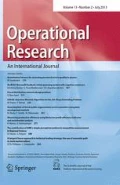Abstract
Geometric programming (GP) is a powerful tool for solving a variety of optimization problems. Most GP problems involve precise parameters. However, the observed values of the parameters in real-life GP problems are often imprecise or vague and, consequently, the optimization process and the related decisions take place in the face of uncertainty. The uncertainty associated with the coefficients of GP problems can be formalized using fuzzy variables. In this paper, we propose chance-constrained GP to deal with the impreciseness and the ambiguity inherent to real-life GP problems. Given a fuzzy GP model, we formulate three variants of chance-constrained GP based on the possibility, necessity and credibility approaches and show how they can be transformed into equivalent deterministic GP problems to be solved via the duality algorithm. We demonstrate the applicability of the proposed models and the efficacy of the introduced procedures with two numerical examples.





Similar content being viewed by others
References
Banker RD, Maindiratta A (1988) Nonparametric analysis of technical and allocative efficiencies in production. Econometrica 56(6):1315–1332
Beightler CS, Phillips DT (1976) Applied geometric programming. Wiley, New York
Boyd S, Vandenberghe L (2004) Convex optimization. Cambridge University Press, Cambridge
Boyd S, Patil D, Horowitz M (2005) Digital circuit sizing via geometric programming. Oper Res 53(6):899–932
Boyd S, Vandenberghe L, Hossib A (2007) A tutorial on geometric programming. Optim Eng 8(1):67–127
Cao BY (1993) Extended fuzzy geometric programming. J Fuzzy Math 1(2):285–293
Cao BY (2002) Fuzzy geometric programming. Kluwer, Dordrecht
Charnes A, Cooper WW (1959) Chance constrained programming. Manage Sci 6:73–79
Danzig GB (1955) Linear programming under uncertainty. Manage Sci 1:197–206
Dubois D, Prade H (1978) Operations on fuzzy numbers. Int J Syst Sci 9(6):613–626
Dubois D, Prade H (1980) Fuzzy sets and system: theory and applications. Academic Press, New York
Dubois D, Prade H (1983) Ranking fuzzy numbers in the setting of possibility theory. Inf Sci 30:183–224
Dubois D, Prade H (1988) Possibility theory: an approach to computerized processing of uncertainty. Plenum, New York
Duffin RJ, Peterson EL (1973) Geometric programming with signomials. J Optim Theory Appl 11(1):3–35
Duffin RJ, Peterson EL, Zener C (1967) Geometric programming: theory and applications. Wiley, New York
Emrouznejad A, Tavana M, Hatami-Marbini A (2014) The state of the art in fuzzy data envelopment analysis. In: Emrouznejad A, Tavana M (eds) Performance measurement with fuzzy data envelopment analysis, studies in fuzziness and soft computing, vol 309. Springer, Berlin, pp 1–45
Kall P, Mayer J (2005) Stochastic linear programming models, theory, and computation. Springer, New York
Khanjani SR, Charles V, Jalalzadeh L (2014) Fuzzy rough DEA model: a possibility and expected value approaches. Expert Syst Appl 41:434–444
Klir GJ, Yuan B (1995) Fuzzy sets and fuzzy logic: theory and applications. Prentice Hall, New Jersey
Kortanek KO, Xu X, Ye Y (1996) An infeasible interior-point algorithm for solving primal and dual geometric programs. Math Program 76:155–181
Lai VJ, Hwang CL (1992) Fuzzy mathematical programming. Springer, Berlin
Liu B (2002) Theory and practice of uncertain programming. Physica Verlag, New York
Liu ST (2006a) A geometric programming approach to profit maximization. Appl Math Comput 182(2):1093–1097
Liu ST (2006b) Geometric programming with parametric uncertainty. Eur J Oper Res 168:345–353
Liu ST (2007a) Profit maximization with quantity discount: an application of geometric program. Appl Math Comput 190(2):1723–1729
Liu ST (2007b) Geometric programming with fuzzy parameters in engineering optimization. Int J Approx Reason 46(3):484–498
Liu ST (2008) Posynomial geometric programming with interval exponents and coefficients. Eur J Oper Res 186(1):17–27
Liu ST (2011) Fuzzy measures for profit maximization with fuzzy parameters. J Comput Appl Math 236(6):1333–1342
Liu B, Liu YK (2002) Expected value of fuzzy variable and fuzzy expected value models. IEEE Trans Fuzzy Syst 10(4):445–450
Luhandjula MK, Gupta MM (1996) On fuzzy stochastic optimization. Fuzzy Sets Syst 81:47–55
Mandal NK, Roy TK (2006) A displayed inventory model with L-R fuzzy number. Fuzzy Optim Decis Mak 5(3):227–243
Passy U, Wilde DJ (1967) Generalized polynomial optimization. SIAM J Appl Math 15(5):1344–1356
Peterson EL (2001) The origins of geometric programming. Ann Oper Res 105:15–19
Rommelfanger H (1996) Fuzzy linear programming and applications. Eur J Oper Res 92:512–527
Sakawa M (1993) Fuzzy sets and interactive multiobjective optimization. Plenum Press, New York
Sakawa M, Katagiri H, Matsui T (2012) Interactive fuzzy stochastic two-level integer programming through fractile criterion optimization. Oper Res Int J 12:209–227
Tavana M, Shiraz RKh, Hatami-Marbini A, Agrell PJ, Paryab K (2012) Fuzzy stochastic data envelopment analysis with application to base realignment and closure (BRAC). Expert Syst Appl 39(15):12247–12259
Tsai JF, Lin MH, Hu YC (2007) On generalized geometric programming problems with non-positive variables. Eur J Oper Res 178(1):10–19
Wang GY, Qiao Z (1993) Linear programming with fuzzy random variable coefficients. Fuzzy Sets Syst 57:295–311
Wu YK (2008) Optimizing the geometric programming problem with single-term exponents subject to max-min fuzzy relational equation constraints. Math Comput Model 47(3–4):352–362
Yang JH, Cao BY (2005) Geometric programming with fuzzy relation equation constraints. In: Proceedings of IEEE international conference on fuzzy systems 2005, pp 557–560
Yang JH, Cao BY (2007) Monomial geometric programming with fuzzy relation equation constraints. Fuzzy Optim Decis Mak 6(4):337–349
Yano H, Sakawa M (2014) Interactive fuzzy programming for multiobjective fuzzy linear programming problems through possibility-based probability maximization. Oper Res Int J 14:51–69
Zadeh LA (1965) Fuzzy sets. Inf Control 8(3):338–353
Zadeh LA (1978) Fuzzy sets as a basis for a theory of possibility. Fuzzy Sets Syst 1(1):3–28
Zhou X, Ahat R (2011) Geometric programming problem with single term exponents subject to max-product fuzzy relational equations. Math Comput Model 53(1–2):55–62
Zimmermann HJ (1996) Fuzzy set theory and its applications, 2nd edn. Kluwer, Dordrecht
Acknowledgments
The authors would like to thank the anonymous reviewers and the editor for their insightful comments and suggestions.
Author information
Authors and Affiliations
Corresponding author
Rights and permissions
About this article
Cite this article
Khanjani Shiraz, R., Tavana, M., Fukuyama, H. et al. Fuzzy chance-constrained geometric programming: the possibility, necessity and credibility approaches. Oper Res Int J 17, 67–97 (2017). https://doi.org/10.1007/s12351-015-0216-7
Received:
Revised:
Accepted:
Published:
Issue Date:
DOI: https://doi.org/10.1007/s12351-015-0216-7




